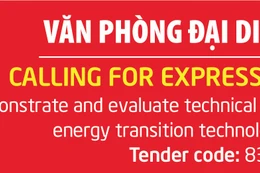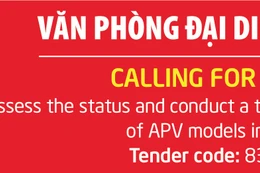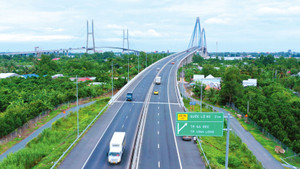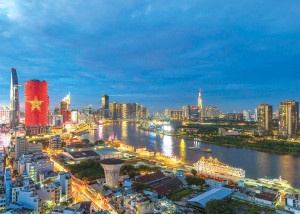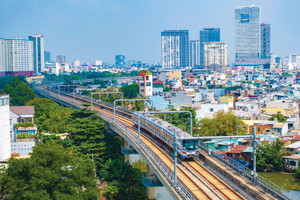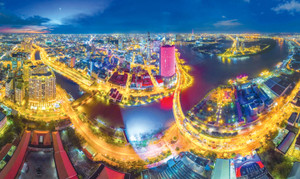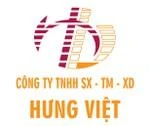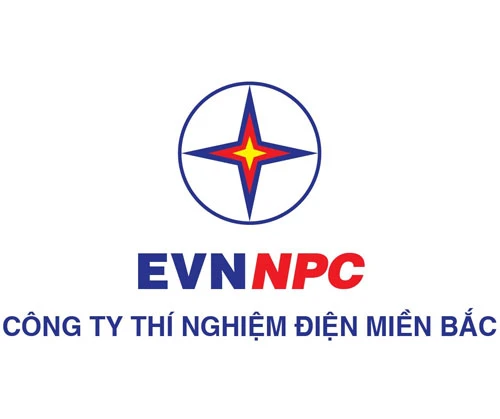Ref. Supplying Imported Coal for Commercial Operation Song Hau 1 Thermal Power Plant in 2022
We, PETRO VIETNAM SONG HAU 1 POWER PLANT PROJECT MANAGEMENT BOARD (SH1PP), who act on behalf of VIET NAM OIL AND GAS GROUP (PVN), manage directly and execute the investment in Song Hau 1 Thermal Power Plant Project. Firstly, SH1PP would like to send you our greetings respectfully and is looking forward to receiving your cooperation.
Currently, PVN/SH1PP is planning to organize to select the Bidder who supplies the imported coal for commercial operation of Song Hau 1 Thermal Power Plant in 2022 with some expected relevant information as Appendix 1 attached herewith.
In order to select a qualified and experienced Bidder meeting the requirements for supplying imported coal for commercial operation of Song Hau 1 Thermal Power Plant in 2022, PVN/SH1PP would like to make an announcement to the Bidders who interest in the above information. Therefore, the Bidders can prepare the necessary contents for the Bid Proposal and promptly participate in the bid right after PVN/SH1PP hold the bidding selection.
Thank you for your kind attention.
Yours sincerely,
| SH1PP Signed Ho Huu Trien. Deputy General Director. |
APPENDIX 1
General information about the package of supplying imported coal for commercial operationof Song Hau 1 Thermal Power Plantin 2022
I. GENERAL INFORMATION
1) Name: Song Hau 1 Thermal Power Plant (2x600MW).
2) The Owner: Vietnam Oil and Gas Group (Petrovietnam). Address: 18 Lang Ha, Ba Dinh District, Ha Noi, Viet Nam. Representative by: Song Hau 1 Power Plant Project Management Board located in Phu Xuan Commune, Mai Dam Town, Chau Thanh District, Hau Giang Province, Viet Nam.
3) Technology: Pulverized coal fired boiler with super-critical steeam parameters.
4) Main fuel: Imported coal, Bituminous or Sub-Bituminous coal.
5) Location: Song Hau 1 Thermal Power Plant is located in Song Hau Power Center, Phu Xuan Commune, Mai Dam town, Chau Thanh district, Hau Giang Province, Viet Nam. Construction location is the Song Hau Industrial Area on the Hau river:
a. approximately 12 km downstream of Can Tho City.
b. approximately 66km upstream of the Dinh An estuary
c. and 180km to the south of Ho Chi Minh City
d. The area of land used: about 115.2 ha
II. PACKAGE INFORMATION (ESTIMATED)
1) Package name: Procurement of coal for commercial operation of Song Hau 1 Thermal Power Plant for 2022.
2) Sources of Funds: Commerial operation capital of Vietnam Oil & Gas Group 2022.
3) Form of bidder selection: international bidding.
4) Timing for bidder selection: expected time in 3rd - 4nd Quarter 2021.
5) The information of coal used for the plant:
- Type of coal: Bituminous or Sub-Bituminous coal.
- Original: imported coal.
- Quantity for commercial operation: about 2,500,000 MT.
Coal specifications as below:
| Specifications | Unit (By Weight) | Range (Design Coal) | Rejection Limit |
| Proximate analysis | |||
| Inherent Moisture | adb % | 1 - 18 | N/A |
| Total Moisture | ar % | Max. 28 | Max. 28 |
| Fixed Carbon | adb % | 35 - 60 | N/A |
| Volatile Master | adb % | 26 - 45 | Min. 26 |
| Ash | adb % | Max. 15 | Max. 15 |
| Total Sulphur | adb % | Max. 1 | Max. 1 |
| HHV | adb, kcal/kg | 5,500 - 6500 | Min. 5500 |
| Grind ability | HGI | 35 - 60 | Min. 35 |
| Size | ≤ 75 mm, % | 100 | Min. 100 |
| ≤ 50 mm, % | Min. 60 | Min. 60 | |
| Ash fusion temperatures Reducing Atmosphere (Initial Deformation) | 0C | ≥1,050 | Min.1050 |
| Ultimate Analysis | |||
| Carbon-C | adb % | 51 - 75 | N/A |
| Hydrogen-H | adb % | 4.0 – 7.5 | N/A |
| Oxygen-H | adb % | By difference | N/A |
| Nitrogen-N | adb % | 1.1 – 1.8 | N/A |
| Chlorine-Cl | adb % | Max. 0.057 | N/A |
- Time of receiving coal for commercial operation: expected in the 1st Quarter, 2022.
- Coal handling system
Coal handling system of Song Hau 1 Thermal Power Plant (Song Hau 1 TPP) includes: 01 coal berth; coal unloading system on the berth with 02 chain bucket ship unloaders with capacity 850 ton/h/machine (max); 02 conveyors, transfer tower; coal yard is designed semi-closed, with capacity 30 days of full load and can extend to 45 days (including 03 storages: 01 center storage with capacity 150.000 ton and 02 side storages with capacity 2 x 102,000 tons); and other equipment: stacker – reclaimer, bulldozer and auxiliaries.
Coal unloading berth of Song Hau 1 Thermal Power Plant is designed with one overhang berth on Hau River in the area of Song Hau 1 TPP (Phu Xuan Hamlet, Mai Dam Town, Chau Thanh District, Hau Giang Province, Vietnam), the basic parameters:
- Berth length: 310m; width 25 m;
- The high top dock 3.50 m
- The high bottom dock-11.85 m
- High water level elevations design + 2.24 m
- High level design -1.77 m
- Approach bridge 1: length 72 m long, width 6 m.
- Approach bridge 2: length 63 m long, width 6 m.
- Coal jetty of Song Hau 1 Thermal Power Plant with the technical parameters as following:
+ Length: ≤ 115m
+ Width: ≤ 26m
+ Depth: < 8m
+ Draft: ≤ 6 m
6) Information for proposal of suppliers:
- Price and delivery terms: CIF at Discharge port/ Coal Jetty of Song Hau 1 Power Plant (Incoterms, edition 2010) including but not limited to whole of related cost/fees such as: freight, insurance, cost of wastage, administration fees…
- The discharge rate is about 7,000 tons/day/CSU from either a TS vessel or self- propelled barge (PWWD SSHINC - per Weather Working Days of 24 consecutive hours, Saturday, Sunday, Holiday Included). In case using 02 CSU to discharge coal for 01 TS vessel or self- propelled barge, the discharge rate is about 10,000 tons/day/02 CSU/TS vessel or self- propelled barge (PWWD SSHINC - per Weather Working Days of 24 consecutive hours, Saturday, Sunday, Holiday Included).
- Methods of payment: Telegraphic transfer (TT) or Letter of Credit (LC) based on the quantity and quality of coal to be discharged and accepted at Discharged port/ Coal Jetty of Song Hau 1 Power Plant.
- Discharge port/ Coal Jetty of Song Hau 1 Power Plant can receive two 10,000 DWT suitable means of conveyance (barges) for unloading cargo at the same time with the technical parameters such as:
+ Length: 110 - 115m;
+ Width: 24 - 26m;
+ Depth: < 8m;
+ Draft: ≤ 6m;
+ Deadweight Capacity: from 6,000 DWT to 10,000 DWT;
+ Dimensions of hatches and holds: Length: > 20m; Width: > 9.5m;
+The nominated TS Vessel or self- propelled barge to discharge at Song Hau 1 jetty must have a structure with double bottom and double hull, water tight cargo hatches, boneless cargo hold with straight vertical walls, maximum 02 cargo holds. Cranes (if any) equipped on the TS Vessel/self- propelled barges must be not be affected and interfered the unloading facilities at Port of Discharge.
III. CHANNEL INFORMATION AND LOCATION OF DISCHARGING TRANSSHIPMENT
1. Channel information
v Information of Thi Vai Channel
- Geography:
+ Thi Vai channel starting from buoy No. “GR5” Ganh Rai Gulf, Vung Tàu Channel - Sai Gon to Phuoc Thai port - Vedan, passing Cai Mep river to Thi Vai River. Left bank is belong to Can Gio district, Ho Chi Minh city, right bank is belong to Tan Thanh district, Ba Ria Vung Tau province and Long Thanh district, Dong Nai province.
+ Thi Vai river system includes Thi Vai River, Go Da River and Cai Mep River. Distance of Thi Vai River to Cai Mep River is about 40 km. Average deep is 15-20m, the deepest is about 30 m at the river fork of Thi Vai, Go Da, Cai Mep. The average width is about 550 m.
- Length: 36.5 km (from buoy No. “GR5” Ganh Rai gulf to Phuoc Thai port)
- Specifications:
+ Irregular semi-diurnal tide, average range: 3.87m.
+ Max water level: 4.70 m.
+ Lowest depth: 9.3m.
+ Minimum radius of curvature is 350m at Tac Ca Trung.
+ According to Notice of Marines No. HCM – 43 – 2012 and VTU – 64 – 2012 for depth after dredging- maintenance Vung Tau – Thi Vai year 2012
+ Channel: area 1 (from Km0-100 to Km0+600); area 2 (from Km1+600 to Km4+800); Area 3 (from Km7+440 to Km26+000), Vung Tau – Thi Vai channel
+ Bottom of channel is designed with breath 310m from Km0-100 to Km0+600 and from Km1+600 to Km4+800. Vung Tau – Thi Vai channel is limited and guided by marine signal system with basis water level “0 marine chart” about 12.0 m.
+ Bottom of channel is designed with breath 310m from Km13+000 to Km17+200. Vung Tau – Thi Vai channel is limited and guided by marine signal system with basis water level “0 marine chart” about 12.8m. Hence, with tidal, vessel have draft about 14m could shifting on this channel, equivalent vessel about 80,000 DWT could be shifting when laden.
v Information of Quan Chanh Bo channel:
Quan Chanh Bo channel is technically passed from 20 Jan 2016. This channel is invested and renovated with total length 46.5 km, including 4 sections: Hau river section has length 12.1 km (from Quan Chanh Bo channel to on the upstream of Hau river), section Quan Chanh Bo has length 19.2 km, section Tat channel has length 8.2 km and section Sea channel has length 7.0 km. This channel is designed for vessel about 15,000 DWT in laden, vessel 20,000 DWT, not laden and vessels have suitable particulars to maneuver. The depth of channel is about 6.5 m in 2016, but now just 4.0 m due to the consolidation of alluvial. Breath of channel is about 85 m and the vessel must maneuver one way only as control of Port Authority. The tidal water level is about 3- 3.5 m, so max draft for the vessel when shifting via the channel is 6 – 6.5 m only.
Quan Chanh Bo channel is designed for vessel above 5,000 DWT due to draft restriction at Dinh An channel. Meantime, as the rule of port authority, small vessel (under 5,000 DWT) or barge with tug pushing (pontoon) is prohibited from shifting the channel due to safety reason. (Limitation of breath, turning basin as well as difficulty when shifting/controlling the barge with tug pushing in the narrowed channel).
v Information of Dinh An estuary and Hau River channel
- Geography:
+ Dinh An estuary locates in sea area of Tra Vinh province. Dinh An channel in Hau River is one of nine estuary of Cuu Long River to the ocean. This channel start from buoy No. “0” and end at Can Tho port, Can Tho city.
+ This channel is separated into two sections: from buoy No. “0” to buoy No. “25” and from buoy No. “25” to buoy No. “102”.
+ Length of channel: from buoy No. “0” to port of Song Hau 1 thermal power plant is about 90 km.
- Characteristics:
+ Semi-diurnal tide.
+ The highest water level at Dinh An Estuary: 4.61 m.
+ Designed width: 100 m.
+ The lowest natural depth: The distance from Buoy No. “25” to Can Tho Port: 7.3 m (from Buoy No. “25” to Buoy No. “31”); the distance from Buoy No. “0” to Buoy No. “25”: this current following is very complicated so dredging operation and float moving are required to take advantage of the nature depth for the vessels to sail normally.
+ The water stream will be stable at the depth of 2,1m in the area from the buoy No. “3”, No. “4” to buoy No. “9”, No. “10”.
+ Designed depth: 3,4m -> 3,8m. No. 0 Marine Chart, for the distance from buoy No. “0” to buoy No, “14”, shows the tricky current of the remaining dune, which maritime signals usually are adjusted to enable the vessels to use the natural depth during sailing time.
+ According to the Maritime Notification No. TVH – 05 -2012 about the depth of Dinh An - Can Tho: the distance from the buoy No. “ 0” to the buoys No. “7” & “8” makes a few scattered shallow points’ appearance with their depth less than 3.5 mm, and from the buoy No. “7” to the buoy No. “14”, the shallow points with a depth of less than 3.5 m lengthen for over 2 km. The most minimum depth is 2.2 m located in 10 m away from the right side of the current, which is the upper buoy No. “9” plus 50 km at the coordinates, Lat 09028’07”6 N/ Long 106026’07”4 E:
+ Due to the particularity of the estuarine area, the annual amount of alluvium is very high so the dredging process has to be maintained accordingly. Therefore, if the plan is to go into Hau River through Dinh An Estuary, it’s necessary to understand the tide schedule and apply it to move through Dinh An Estuary when the water reaches the appropriate level in the mudflats. For safety reason and due to draft restriction, nowadays vessel above 5,000 DWT should shift to Song Hau 1/ Can Tho via Quan Chanh Bo channel.
2. Information of Transshipment Location
v Go Gia, Vung Tau:
+ Go Gia Transhipment is currently managed by Ho Chi Minh Port Authority. Ministry of Transport approved the proposal of Go Gia having more 11 pairs of anchor buoy for ships from 30,000 – 150,000 DWT. However, the tonnage of a ship must also be compatible with the navigation channel. At present, the depth of the Go Gia River is very large and its lowest water level is 13.9 m. However, the distance from Buoy No. “0” of Vung Tau to Go Gia River via Thi Vai Channel, only the ships from 70,000 to 80,000 DWT can be accepted to shift because of the limited depth at Thi Vai. The dimension of the anchoarge should be large and convinient enough for transhipment.
+ Bulding two turning basins with the diameters, 550 m and 380 m has been chosen to be one of the upcoming projects. However, Go Gia currently has 2 pairs of buoy with the allowed deadweight of 60,000 DW belonging to Hung Thai company. In order for the chosen project to start, these 2 pairs of buoy will need to be removed.
+ The distance from Buoy 0 to the anchorage is very close and is closer to Song Hau Themalpower Plant than Thieng Lieng Anchorage.
+ Note: If you look for a transshipment location for ships over 70,000 DWT, the best consideration will be Go Gia due to its nature depth in the South East.
v Thieng Lieng, Ho Chi Minh city
+ Thieng Lieng Transshipment Area is under the management of Sai Gon Port Authority. It is about 15 miles away from the Buoy No. 0 Vung Tau.
+ The depth: 8.5 m.
+ There are 3 mooring buoys which are compable with the 60,000 DWT vessels with the depth of 13.5 m.
+ The productivty of unloading goods by means of a crane is estimated to be 8,000 tons/ day (3 shifts including weekends) under the good weather condition.
+ However, the width of Thieng Lieng anchorage is fairly narrow, and the accessible entrance reaches 12 m (including tides) from Vung Tau. In fact, only 50,000 DWT laden vessel are accepted.
v Soai Rap, Ho Chi Minh city
+ Soai Rap Anchorage is under the management of Sai Gon Port Authority. 5 miles is the distance from its location to the Buoy No. 0.
+ The depth of 9.5 m combined with tides enables the 30,000 DWT carriers under laden situation or 50,000 DWT carriers under offload to travel. As planned, it will be next to dredge until a particular depth of 12 m to ensure the 70,000 DWT ships to pass through while taking advantages of tides.
+ According to the proposal of Ho Chi Minh Port to Vietnamese Maritime Administration, Soai Rap River will have 14 berths including 6 berths for 70,000 DWT ships, the other six for 50,000 DWT vessels, and the remaining one for 30,000 DWT vessels. Besides that, 13 mooring buoys are available to use for smaller vessels in the range of 1,000 – 3,000 DWT.
+ The advantage of this Transshipment area is its large width. Compared to Go Gia Anchorage, this advantage makes the distance to Long Phu 1 and Song hau 1 Thermal Power Plant to be about 12 nautical miles closer.
+ In order for 70,000 DWT vessels to be in service, it depends on the rate of dredging process III.
v Estuary of Song Hau Area
+ General information: In order to perform the transfer of coal in the area in out side of the Dinh An estuary in good weather season (from March to October every year). Coal transport projects will be done in the area of license by Vietnam Ministry of Transportation. This area is the transshipment zone for the clusters of thermal power plants in the Mekong Delta include: Duyen Hai, Long Phu 1 and Song Hau 1.
+ The depth of transshipment zone: According to the BA Chart – 3986, the depth of transshipment zone is varies from 15m to 20m which is suitable for Supramax ship and Panamax ship. In addition, this depth is also safe for the operation of floating cranes and barges.
+ The influence of the weather (wave, wind, climate…etc): Typical weather conditions include sea waves, weather, winds which is sometime directly afftect the handling of floating cranes. At the time of the survey, the wave height ranged from 0.5 to 0.6 meters. However, in the months before the northeast monsoon coming, the oscillation of the waves have be measured about 0.8 to 1.3 meters. In the bad weather conditions, the wave height maybe up to 4 meters. Therefore, during the bad weather season (from November to February every year), when the wave height is over 1.5 meters which will directly affect the coal conveying equipment down to the barge. At that time, the coal conveying will be changed at another area such as Go Gia Anchorage or Thieng Lieng Anchorag.
Remarks: The information stated in Item III above is for reference only and Suppliers/ Sellers shall take all responsibility for transportation/ transshipment. The Suppliers/ Sellers, by their own cost, conduct the information researches, investigates, evaluations and calculations in terms of the CIF terms (International Commercial Terms, 2010 edition) at Discharge port/ Coal Jetty of Song Hau 1 Power Plant and other related fees.



